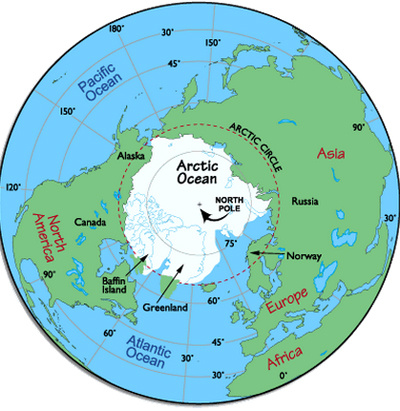Vessels can cross the Arctic in 2050
If the Arctic ice sheet continues to melt at the current rate, seagoing vessels could run through the north pole of the planet in the middle of the 21st century.
Global warming causes the thickness of the Arctic ice to drop sharply over the past 7 years. With the current situation, some icebreakers have been able to move across northern Russia. Last year a total of 46 ships crossed the Arctic. Most of them were escorted by Russian icebreakers at a large cost, Guardian reported.

Distance and time travel from the Pacific and the Atlantic Ocean
of ships will fall sharply if they cross the Arctic Ocean.
"By 2050, conventional vessels will easily be able to move across the Arctic Ocean, while icebreakers can move along the shortest route between the Pacific and Atlantic, ie beyond the north pole of the earth, " said Laurence Smith and Scott Stephenson, two researchers at the University of California in the US.
To draw this conclusion, the two researchers introduced two types of ships - conventional vessels and icebreakers - into the model to see if they were capable of crossing the Arctic at different stages of the year. . They found that the sea routes across the Arctic were clearly visible after 2049.
If north Norway goes to Central, medium-sized vessels can cross the north pole, the time it takes for a ship to travel from the country to reduce by 18 days. Ship owners say the average size vessel passing through the Arctic will help them save between 180 and 300 thousand pounds per transfer, while reducing fuel and time by 40%.
Scientists say that when ships can run through the north pole, transport costs between Europe and Asia will fall, but many new economic and environmental challenges will arise.
- The first gas tanker crossed the Arctic
- Print human blood vessels with 3D printers
- Interesting facts about animals living in the Arctic
- Intact salvage of ceramic vessels dating back more than 2,000 years
- Apple develops device that predicts heart attack by listening to blood vessels?
- 3D blood vessels
- Sitting cross-legged - Causes of many diseases
- Arctic sea ice area is at a record low
- Every second 14,000 tons of water flows into the sea because the Arctic ice melts
- Blood vessels cultured from skin cells
- The volume of ice in the Arctic drops to a record low
- The Arctic lost three times as much ice as Belgium every day
 Is the magnetic North Pole shift dangerous to humanity?
Is the magnetic North Pole shift dangerous to humanity? Washington legalizes the recycling of human bodies into fertilizer
Washington legalizes the recycling of human bodies into fertilizer Lightning stone - the mysterious guest
Lightning stone - the mysterious guest Stunned by the mysterious sunset, strange appearance
Stunned by the mysterious sunset, strange appearance